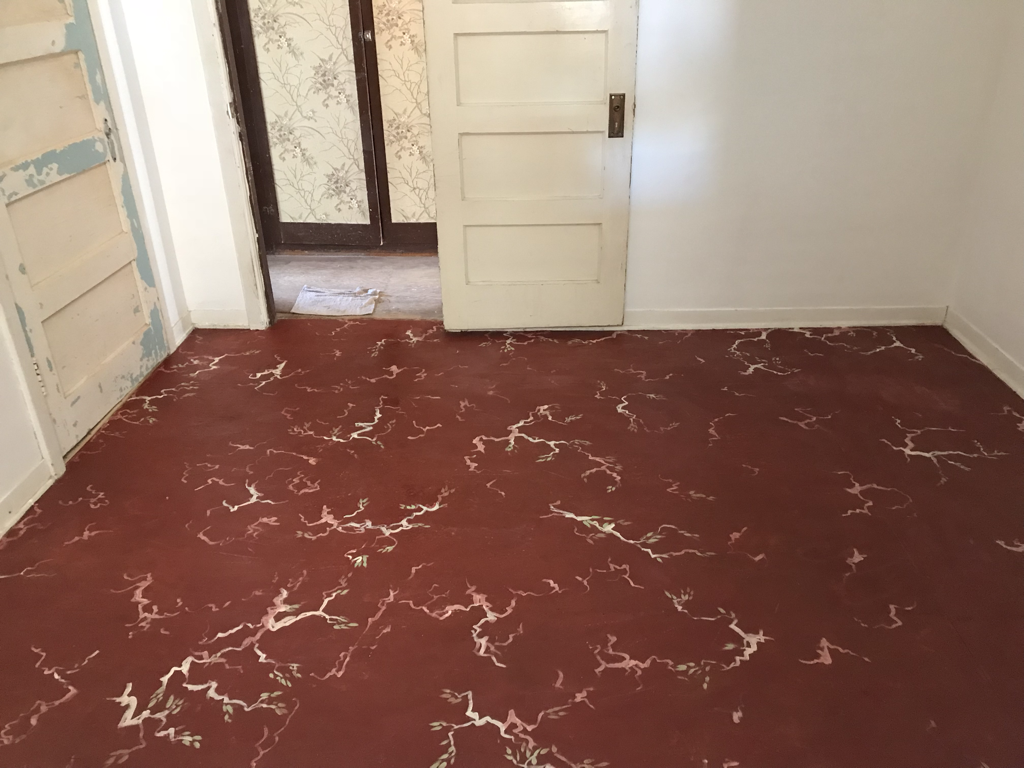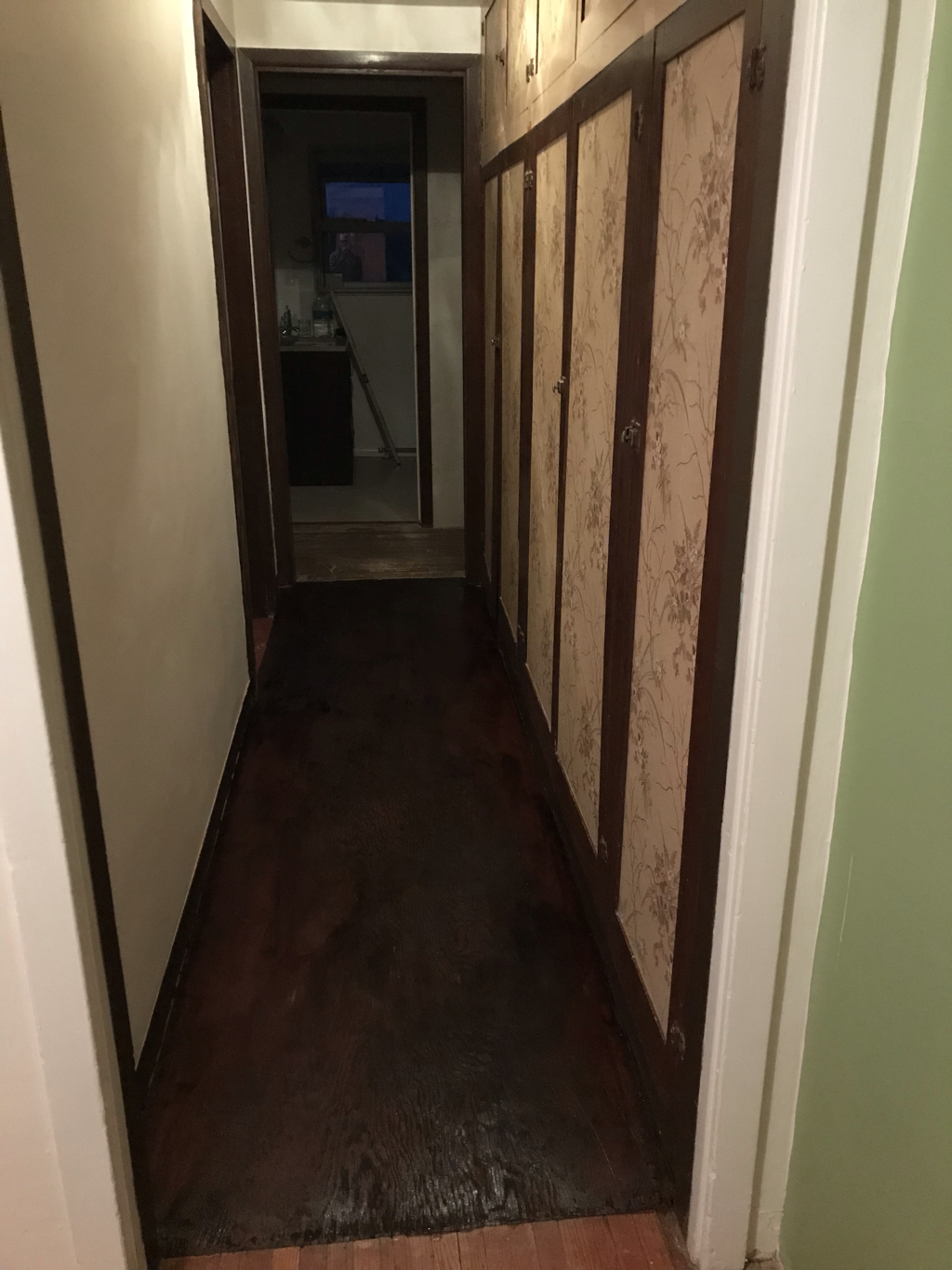|
I’m starting to work minutely on the core of the farmhouse: a room we call the office, and the hallway. As I clean, scrape and paint, I uncover clues to the past residents—who they were and how they lived. What we call our Desert Dairy was built in 1930 and 1932: two buildings recorded by San Bernadino County, a barn and a house. There are remnants of outbuildings that also served the dairy: an outhouse, a shed with a refrigerated room (with a wood door over 12” thick), and a secondary milking barn. There was water and the area must have been lush. I imagine a couple from the mid-west (Utah because we are off Utah Trail), pre-Dust Bowl, and pre-Homestead Act of 1938 (in which you could get 5 acres of land and build a 400 square foot Jackrabbit Homestead)—I think our acreage was originally larger to support a dairy farm. Our original house was probably less than 600 square feet, and had neither bathroom nor electricity (explains why we have almost no light switches). A large porch wrapped around the eastern and southern sides, which was quickly enclosed. In fact, the original owners enlarged the house by 9’ on every side (like a donut), adding a bathroom and formal kitchen, and pushing the fireplace to the interior of the house, along with exterior windows and door openings. The basement, or root cellar, is dug out below the original house, and the trapdoor (a la Wizard of Oz), once on the exterior of the house, is now in the laundry room floor. And yes, it’s a bit scary. The original farmhouse was painted green, and the trim was bright aqua and orange (super cool that we chose green and orange as our colors, without knowing this!). We are hoping to hold on to our beautiful fireplace, and saving as many details of the original building as we can. Here are my imaginings on the past owners… From 1930 to 1960 our property functioned as a dairy farm. With young children, they lived the rural life (the population of Twentynine Palms in 1970 was only about 5000), and then sold the farm because the water ran out and the children moved to LA. We found evidence of blacksmithing, canning, old milk crates… but this family remains in shadow for me. The next family that moved in was the one that sold the property to us. The owner was four years old when she moved to the property, and she sold it to us in her late 60s. Her father and brother were miners, which explain the abundance of exotic rocks all around the house. Her father was also an artist, and made plaster and concrete casts. Today I scrubbed the narrow hallway which includes the original closets with wallpapered cabinets: up high they were blackened with cigarette smoke, and low they were covered with splashes of coffee and dirt. I imagine all the encounters that occurred in that hallway: early morning bumping and late night drunken brawling. You can’t pass without rubbing shoulders. But I’m grateful to have the original panels, which I love. All the original doors are still in the house, including pocket doors that separate the living room from the kitchen. Solid paneled doors are pocked and gashed with living that sometimes looks violent. As the second family sunk into poverty, life became hard. There is evidence of culture--we found encyclopedias and sets of china in the yard--but we saw fear, too—the master bedroom had multiple bolt locks on the door, as if the owner barricaded herself in. This is not a luxurious house, by a long shot. It’s a hard-working, tough-living house that is dusty and beyond worn, but still functional. Drama and pain happened here, you can feel it. But people also loved the simple life—they sat around bonfires, they dreamed of finding gold, they raised children whose names are still on paint cans in the shed. In the end, they sold their property as a trash dump and rented space to drug addicts in order to survive. We’re going to do better. the office, with hand painted floor inspired by hallway panels. The hallway, patched and cleaned up.
2 Comments
Anna
11/29/2018 02:43:57 pm
One of our neighbors, who I just met, told us the brother of the second family spent years in prison for robbery, and when he got out the neighbor kept his distance. We are encountering the deep and hidden pain of rural poverty here, all around us.
Reply
Your comment will be posted after it is approved.
Leave a Reply. |
Archives
July 2024
Categories
All
AuthorsAnna does most of the writing. Ted does most of the photos. But sometimes we switch. We are repairing a distressed property in 29 Palms, California, and eventually hope to run an artist residency there. |


 RSS Feed
RSS Feed